Posted by: Northwest Eye in General on October 27, 2025
Overview
The main focus of this article is to ensure your safety when using color contact lenses through proper prescription and care practices. We understand that many individuals may have concerns about the risks involved, such as infections and discomfort. That’s why it’s crucial to obtain a professional prescription. Not only does this minimize risks, but it also enhances your overall eye health and satisfaction with the lenses.
By seeking personalized assessments, you can feel more confident in your choice. We are here to help you through this process, ensuring that you have the best care possible for your eyes. Remember, prioritizing your eye health is essential, and taking the right steps can lead to a more enjoyable experience with color contact lenses.
Introduction
Color contact lenses have seen a remarkable rise in popularity, transforming not only how individuals perceive themselves but also how they express their unique style. With the colored eye accessories market projected to reach $6.3 billion by 2029, we understand that the demand for personalized and safe color contact prescriptions is more critical than ever. However, it’s common to feel a mix of excitement and concern about these vibrant hues, as improper use can lead to serious eye health issues.
What are the essential steps to ensure safety and comfort while enjoying the aesthetic benefits of color contacts? This article delves into ten crucial tips that empower you to navigate the world of colored lenses with confidence and care.
Northwest Eye: Personalized Color Contact Lens Prescriptions
At Northwest Eye, we understand how vital it is for our patients to have customized color contacts prescriptions that are tailored to their unique eye shape and vision needs. This personalized approach not only ensures a proper fit but also minimizes discomfort and potential eye health complications. Our skilled ophthalmic surgeons conduct thorough assessments to identify the best options for each patient, balancing aesthetic appeal with functional effectiveness.
With the colored eye accessories market projected to grow to $6.3 billion by 2029 at a CAGR of 10.6%, the importance of tailored evaluations has never been more critical. As one eye specialist noted, ‘Personalized fitting of corrective eyewear is essential for guaranteeing both comfort and visual clarity.’ By prioritizing these personalized assessments, we enhance overall patient satisfaction and safety, which includes ensuring the correct color contacts prescription, creating a positive experience in eye care.
We encourage you to consult with your eye care provider to explore personalized options that truly meet your specific needs. Remember, we are here to help you through this process, ensuring that your vision is both beautiful and clear.
Importance of Professional Color Contact Lens Prescriptions
Obtaining a professional color contacts prescription for tinted ocular accessories is crucial for protecting your eye health. We understand that you may have concerns about the color contacts prescription, as they carry specific risks if not fitted correctly. A qualified eye care professional will evaluate your eye health, considering symptoms such as blurred vision, dry eyes, and macular degeneration, which may indicate underlying conditions. They will suggest suitable types of optics and provide essential advice on safe usage practices.
This oversight is vital in mitigating potential complications, such as infections and corneal abrasions. Alarmingly, 60% of fake cosmetic eye lenses were discovered to have microbial contamination, highlighting the dangers of using unprescribed products. By emphasizing professional evaluations, you can ensure that your color contacts prescription is customized to your personal requirements, greatly diminishing the chances of negative outcomes.
Remember, it’s common to feel overwhelmed, but scheduling regular eye exams is a proactive step towards maintaining optimal eye health. We are here to help you through this process.

Types of Color Contact Lenses: Options and Variations
Color contact options are available in various types, each designed to fulfill particular aesthetic preferences and comfort levels. We understand that choosing the right lenses can be a personal journey, and we are here to help you through this process. The primary categories include:
- Visibility Tint: These lightly tinted lenses enhance visibility during handling, making them easier to manage for users.
- Enhancement Tint: Semi-transparent eyewear that intensifies the natural hue of the eyes, offering a subtle yet noticeable improvement.
- Opaque Tint: These lenses completely conceal the natural eye hue, enabling striking alterations and artistic expressions.
- Scleral Discs: Larger devices that cover the entire sclera, often utilized for special effects in theatrical or costume applications.
Understanding these options is crucial for making informed choices. Each variety of optical filter provides distinct advantages; for example, enhancement tints are preferred for their capacity to intensify natural eye hues, while opaque tints are well-liked by individuals desiring a striking transformation. Recent statistics indicate that approximately 65% of consumers prefer enhancement tints, while 25% opt for opaque tints, reflecting a trend towards more expressive eye aesthetics.
It’s common to feel uncertain about which option to choose. Real-world experiences emphasize the adaptability of these optical devices. Many users report that enhancement tints not only improve their appearance but also boost their confidence during social events. For instance, a user named Sarah shared, “Wearing enhancement tints made me feel more vibrant and confident at my friend’s wedding. It was a subtle change, but it made a big difference in how I felt.”
Advancements in optical technology, including enhanced oxygen permeability and comfort attributes, continue to improve the user experience, particularly with color contacts prescription, making tinted corrective and cosmetic options a favored selection. As the market evolves, staying informed about the latest advancements and consumer preferences will empower you to select the best options for your needs.
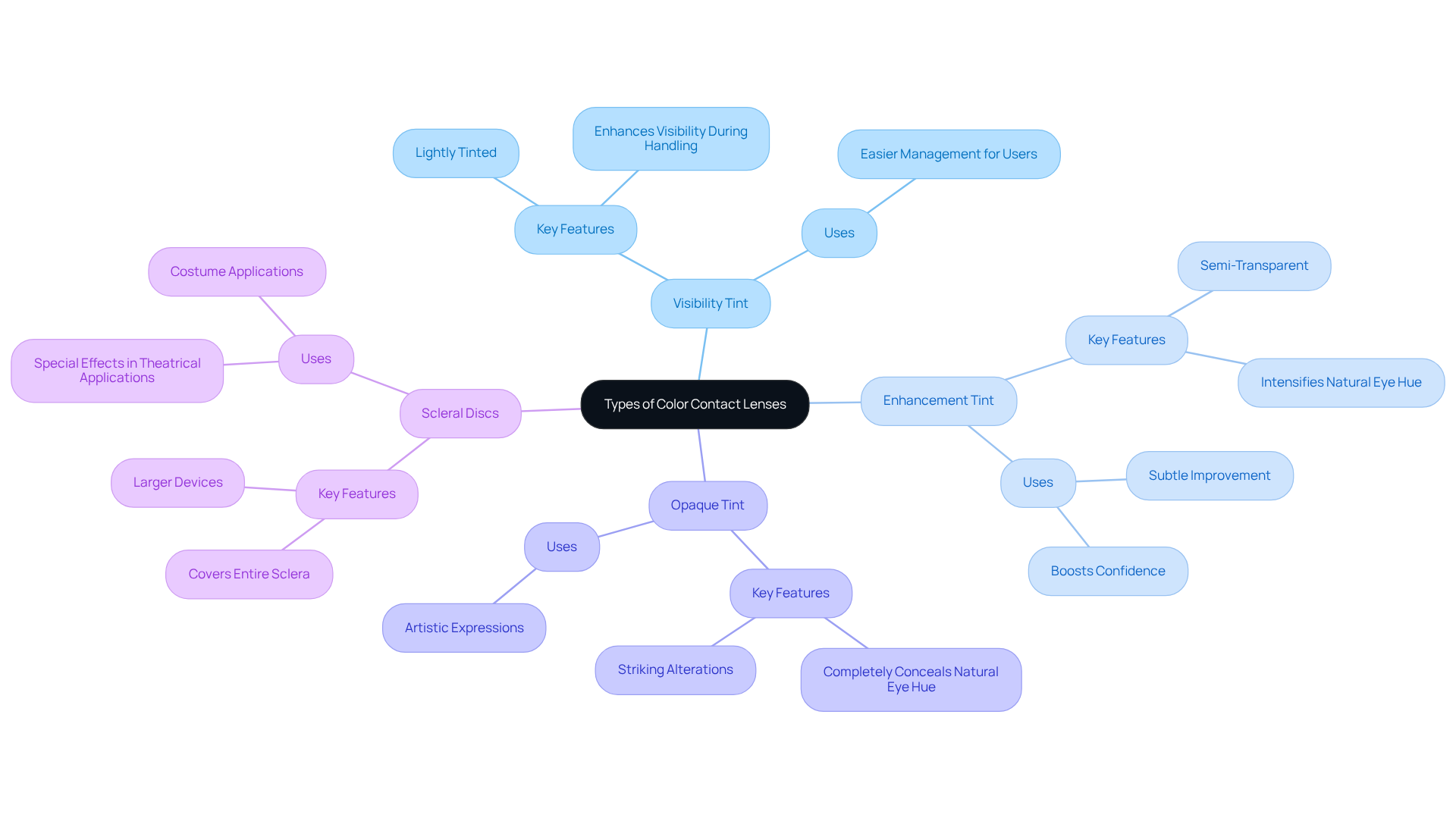
Understanding Fit and Comfort in Color Contact Lenses
Achieving the right fit and comfort is essential for anyone considering a color contacts prescription. We understand that finding the perfect optical device can be overwhelming. A well-fitted optical device sits correctly on the eye, allowing for natural movement and significantly reducing the risk of irritation. Key factors that affect the fit include:
- The curvature of the optical element
- The size of the eye
- The material utilized in its construction
Research shows that improper fitting can cause discomfort, with around one-third of contact wearers stopping use due to irritation and low vision quality.
To ensure optimal comfort, we encourage patients to engage in thorough consultations with their eye care providers. During these appointments, professionals evaluate individual eye traits, including curvature and diameter, to choose the most appropriate optical devices. This tailored method not only improves comfort but also encourages healthy vision by ensuring sufficient oxygen circulation and proper positioning of the optics. As one eye care expert pointed out, “A professional fitting guarantees that the eyewear permits sufficient oxygen circulation and keeps proper alignment, supporting healthy eyes.” Furthermore, it’s common to feel concerned about the risks; badly fitted eyewear can result in severe problems such as corneal abrasions and infections, emphasizing the significance of a suitable fit.
Besides fitting, knowing how to maintain tinted eyewear is essential. Patients should be educated on proper insertion, removal, and maintenance techniques to maximize comfort and minimize risks. This involves:
- Making sure hands are clean prior to touching optical devices
- Utilizing the proper cleaning solutions
- Adhering to a regular replacement timetable
By emphasizing fit and comfort, users can appreciate the aesthetic advantages of tinted lenses without sacrificing their eye health. We recommend scheduling fitting appointments with your eye care provider to ensure you receive expert guidance tailored to your color contacts prescription needs.
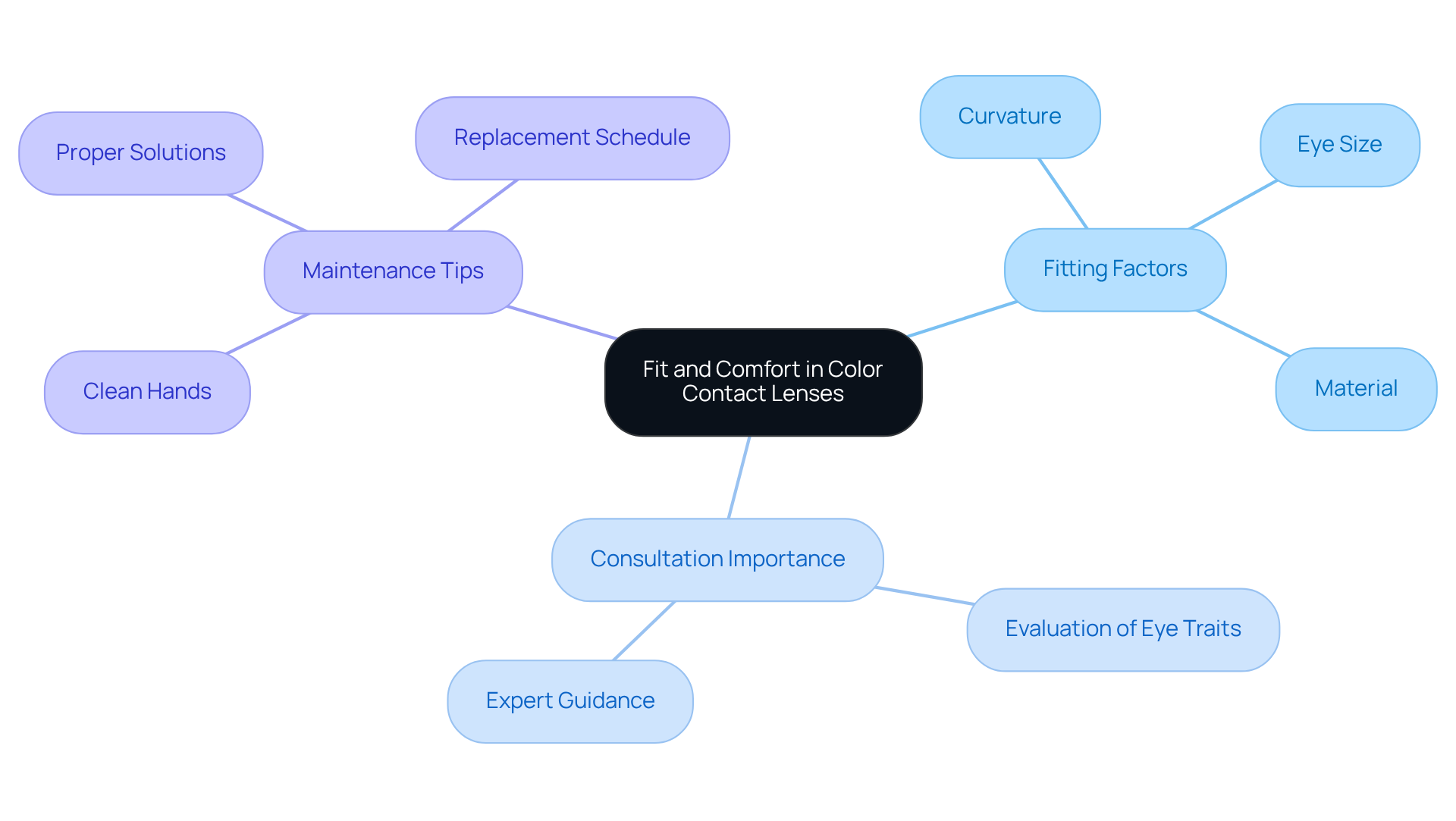
Regular Eye Exams: Essential for Color Contact Lens Users
Routine eye examinations are essential for those who use a color contacts prescription. We understand that your eye health is a priority, and these examinations allow eye care professionals to monitor your well-being, identify any signs of irritation or infection, and ensure that your prescriptions are up to date.
Most specialists, including the Canadian Association of Optometrists, recommend that users of corrective eyewear, particularly those with a color contacts prescription, arrange an eye examination at least annually. However, if you experience discomfort or notice changes in your vision, it’s common to feel the need for more frequent visits. Dr. David Jupiter emphasizes that regular checkups are not merely a suggestion; they are an essential requirement for users of corrective eyewear. This practice helps avoid issues like dry eye syndrome and corneal damage.
Routine exams not only help catch potential issues early but are also vital for maintaining overall eye health. By following this timetable, you can significantly decrease the chances of complications related to wearing lenses, ensuring a secure and pleasant experience. Remember, we are here to help you through this process, and your eye health matters.
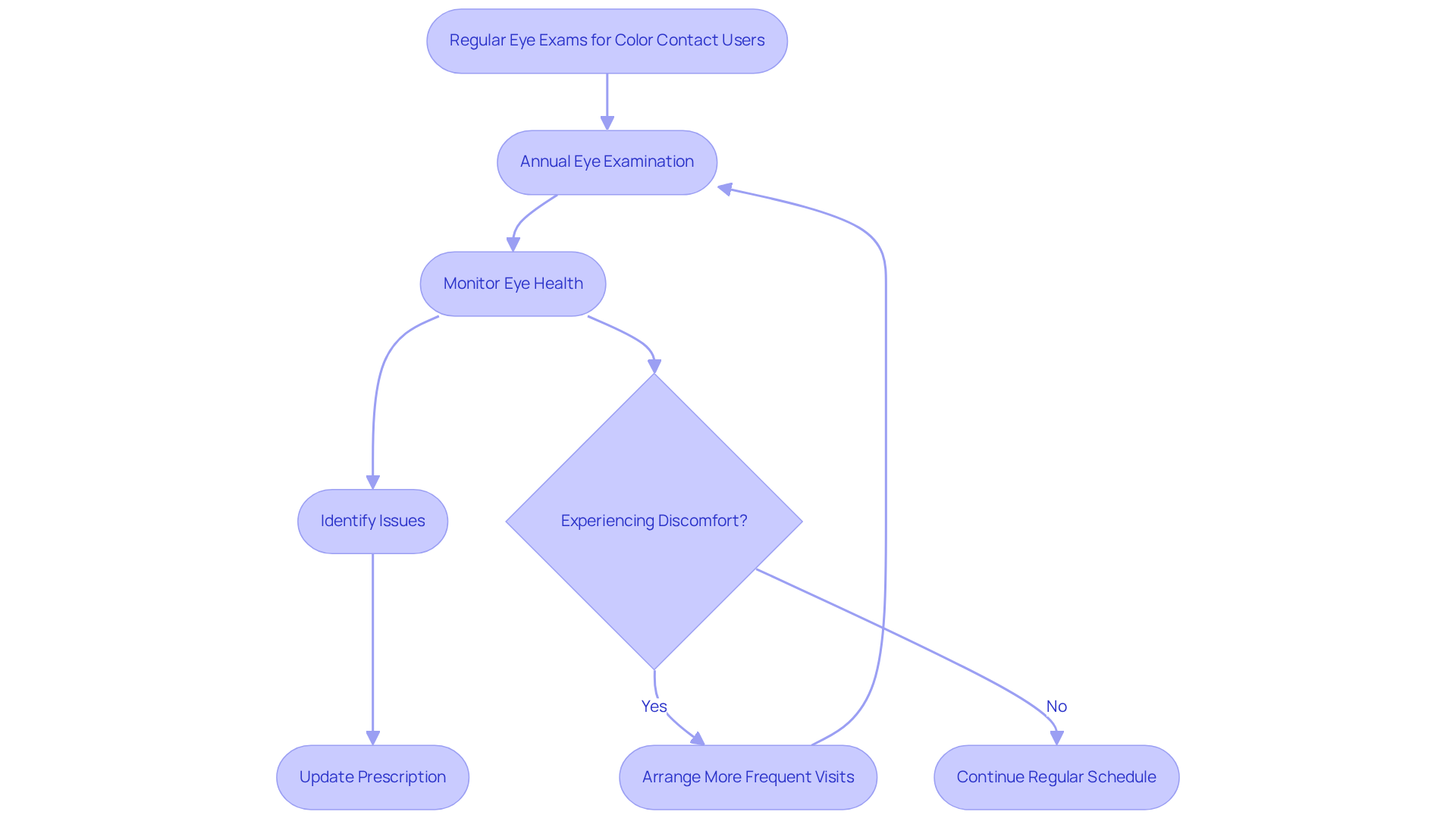
Risks of Improper Use of Color Contact Lenses
Improper use of color contacts prescription lenses can lead to several serious eye health issues, so it’s important to be aware of these risks to ensure your safety and comfort. Here are some potential concerns:
-
Infections: We understand that the thought of infections can be alarming. Bacterial growth can occur if lenses are not cleaned properly. A significant concern is microbial keratitis, which can arise from poor hygiene practices. Research suggests that around 20% of contact-related infections lead to damage, especially associated with microbial keratitis, highlighting the significance of proper care.
-
Corneal Abrasions: It’s common to feel discomfort when wearing ill-fitting contacts. These can scratch the cornea, leading to pain and potential vision loss. Data indicates that improperly fitting eyewear is a frequent source of corneal abrasions, which can lead to significant discomfort and complications if not dealt with swiftly.
-
Allergic Reactions: Some users may experience allergic responses to the material or cleaning solutions. These reactions can manifest as redness, irritation, or discomfort, prompting the need for immediate consultation with an eye care professional.
Awareness of these risks is crucial for safe use. Proper hygiene and care are essential to minimize complications. Regular meetings with an eye care expert can provide tailored advice and ensure that you are knowledgeable about the optimal methods for preserving your eye health while using color contacts prescription.
We recommend changing contact cases every three months to decrease infection risk. It’s also important to refrain from exposing contacts to water, as this can heighten the chances of infections. Adhering to these guidelines can assist in promoting a safer experience with colored eye coverings. Remember, we are here to help you through this process.
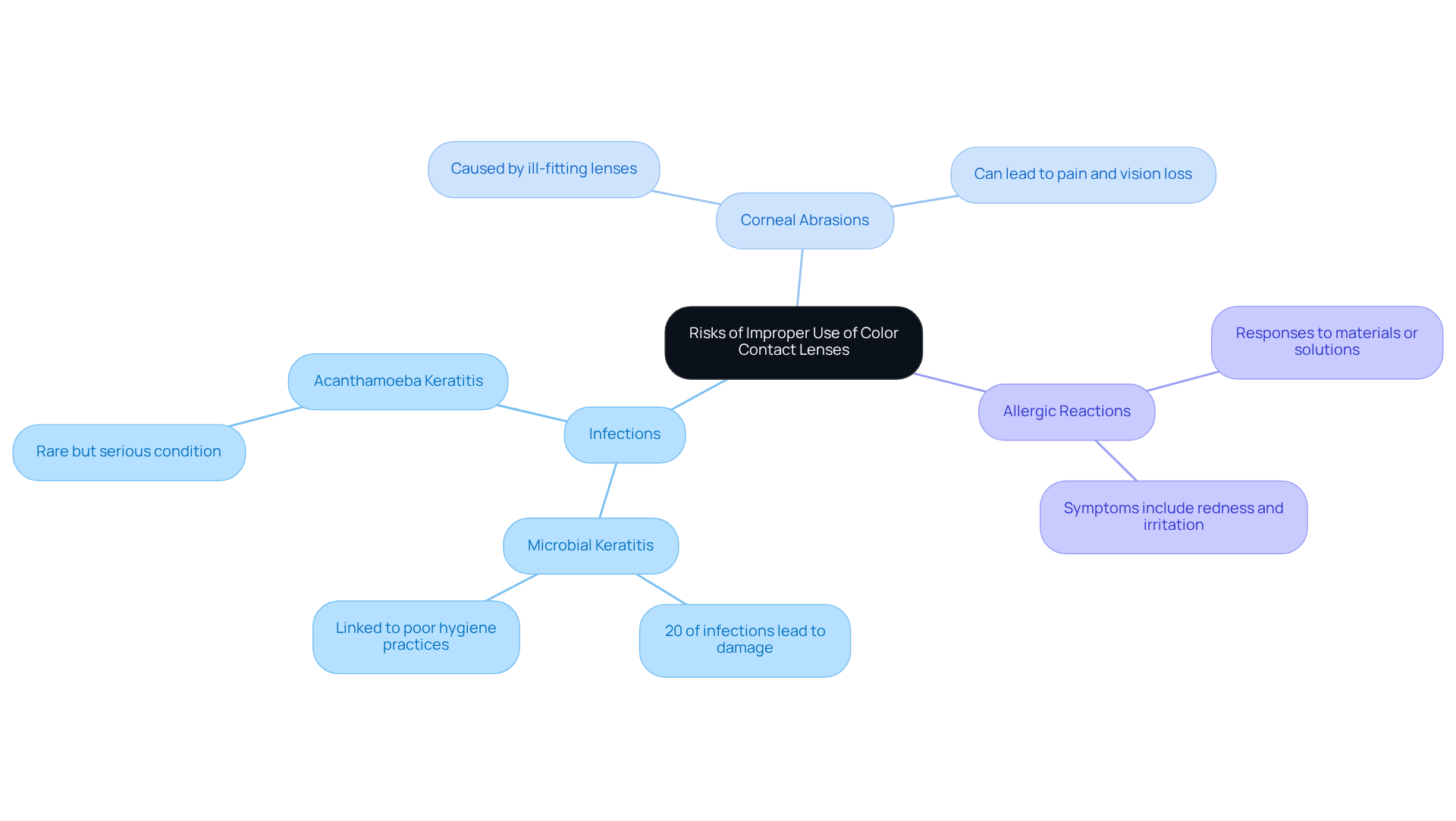
Patient Education: Key to Safe Color Contact Lens Use
Education is essential for the safe use of tinted eyewear. We understand that patients may have concerns about how to properly care for their lenses, and it’s crucial to be well-informed about several critical aspects:
- Proper Handling and Care: It’s important to clean and store lenses correctly to prevent infections and discomfort. This includes using appropriate cleaning solutions and following a strict hygiene regimen. As noted by IQ Laser Vision, ‘Adhere to appropriate handling and hygiene practices to preserve eye health when using colored eyewear.’
- Signs of Complications: It’s common to feel uncertain about what symptoms might indicate issues. Patients should be educated on signs such as redness, discomfort, or blurred vision. Recognizing these early can help prevent serious complications like corneal abrasions or infections.
- Usage Guidelines: Clear instructions on how long to wear contacts and when to take them off are vital. Adhering to recommended wear times helps mitigate risks associated with prolonged use.
Informed patients are safer patients. Studies show that education significantly lowers the likelihood of issues associated with wearing lenses. For example, research indicates that more than half of users of corrective eyewear do not adhere to appropriate cleaning practices, which highlights a significant deficiency in understanding. Specifically, 52% of participants did not follow wear and care regimens for their eyewear, underscoring the necessity for effective education.
Effective patient education strategies include providing comprehensive resources during consultations, utilizing visual aids, and conducting follow-up sessions to reinforce best practices. As IQ Laser Vision emphasizes, consulting an optometrist or ophthalmologist is crucial before using products that require a color contacts prescription to ensure proper fitting and reduce risks. By prioritizing education, eye care specialists can empower patients to make informed choices, ultimately enhancing their safety and satisfaction with colored vision aids.
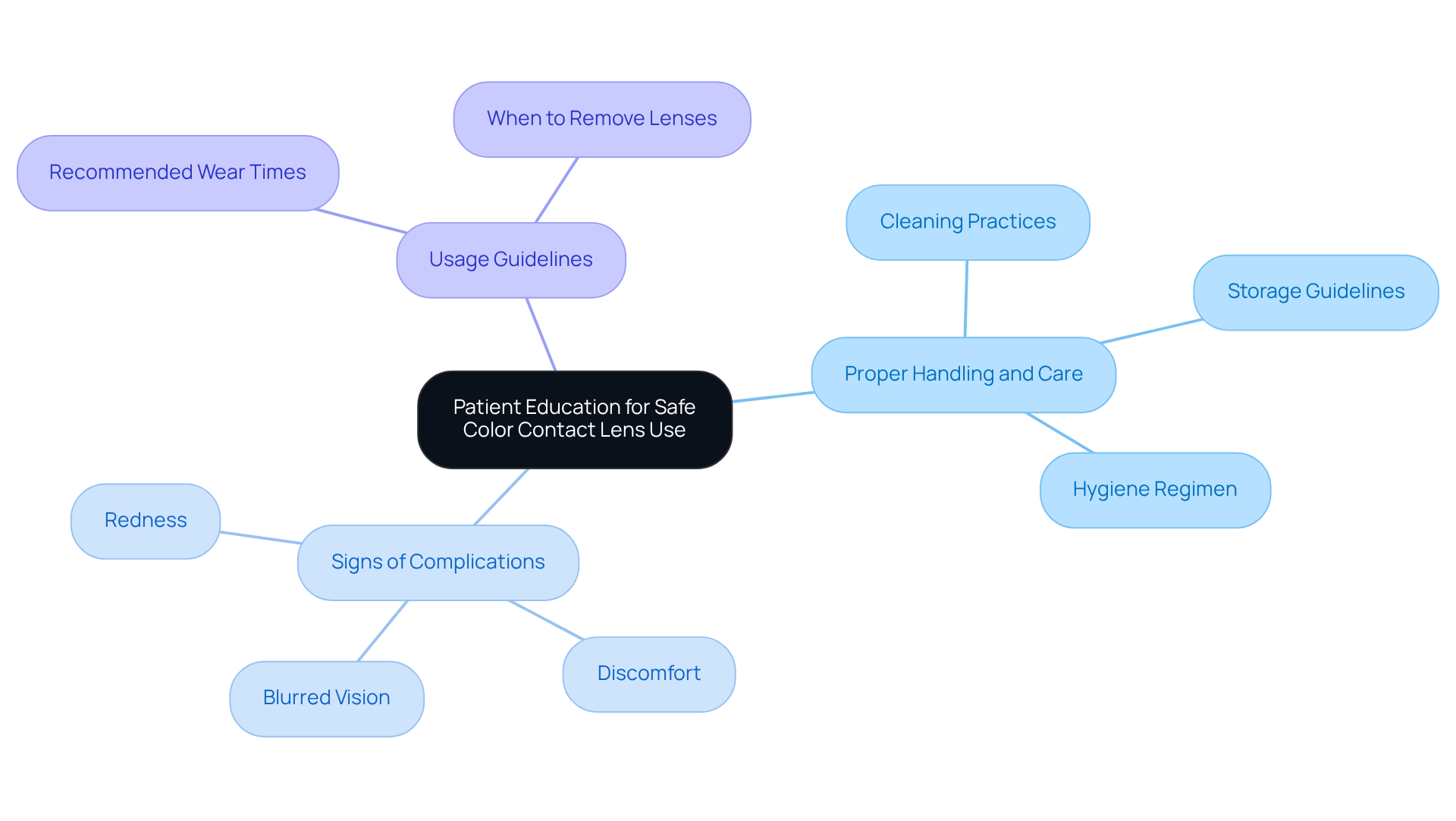
Aesthetic Benefits of Color Contact Lenses
Color contact lenses offer a multitude of aesthetic benefits that can truly transform your appearance and boost your confidence.
- Enhanced Eye Color: These lenses can intensify or completely change your natural eye color, providing a fresh and vibrant look that draws attention.
- Fashion Statement: Colored eyewear serves as a versatile accessory, allowing you to complement your outfits or express your unique personal style. Many fashion-forward individuals select eyewear that enhances their clothing or makeup, creating cohesive and striking looks. It’s common to see that most consumers of colored eyewear are between 18 and 40 years old, reflecting a significant interest among younger groups influenced by social media and celebrity endorsements.
- Special Effects: Certain optical devices are crafted for dramatic transformations, ideal for occasions like Halloween or cosplay, where they can help you achieve character representations or striking fashion statements.
The increasing appeal of colored eye accessories, such as color contacts prescription, indicates a wider movement in personal grooming and aesthetic improvement. Celebrities like Selena Gomez and Lady Gaga have showcased tinted contacts to enhance their appearances for music videos and red carpet events, further increasing their popularity. As highlighted by industry specialists, colored eyewear has evolved into a multifunctional fashion item that allows for limitless creativity and self-expression.
As the market for tinted eyewear continues to grow, many consumers are drawn to the idea of using color contacts prescription not only for vision correction but also as a means of self-expression and creativity. With choices ranging from natural tones to vivid hues, tinted eyewear has become essential fashion items that enhance inherent beauty and provide endless opportunities for personal style. Key players in the market, such as Johnson & Johnson and Alcon, are continuously innovating to meet consumer demands, ensuring a wide variety of choices available for enhancing personal style.
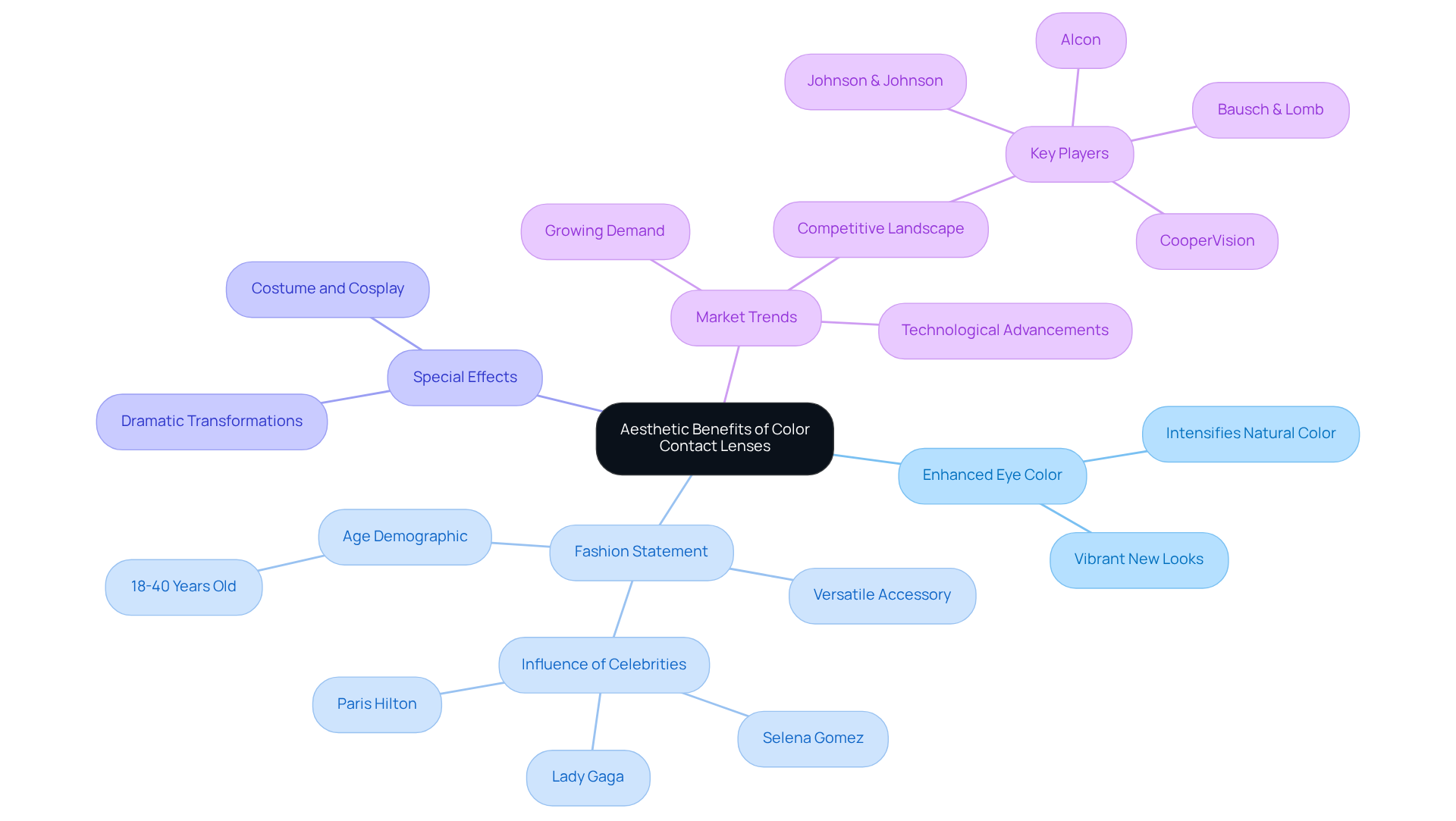
Care Instructions for Color Contact Lenses: Best Practices
To ensure the longevity and safety of your color contact lenses, we understand how important it is to follow these best practices:
- Clean and Store Properly: Always wash your hands thoroughly with soap and water before handling your colored contact lenses. We recommend using a suggested cleaning solution and keeping your optical devices in a tidy, specified case. This simple step prevents contamination and helps preserve the integrity of your lenses. Remember to change your container every three months to reduce bacterial growth.
- Avoid Water Exposure: It’s common to feel concerned about the safety of your lenses. Please never rinse your contact devices with water or saliva, as these can introduce harmful bacteria that may lead to serious infections, such as microbial keratitis. This condition occurs at an incidence of 2-4 per 10,000 users for daily wear and 20 per 10,000 for extended wear. Keeping your lenses dry and away from water sources is essential for your safety.
- Follow the Replacement Schedule: We encourage you to adhere to the recommended timetable for changing your optical devices, which requires having a current color contacts prescription, typically every month for monthly options. This practice helps prevent the buildup of deposits and ensures optimal comfort and hygiene. Dispose of your contacts after three months of being open, regardless of usage, to avoid possible complications.
Proper care not only prolongs the life of your eyewear but also plays a crucial role in preserving your overall eye health. Regular consultations with an eye care specialist can assist in monitoring your eye health and ensuring that your eyewear fits properly, further decreasing the risk of issues related to improper eye care. As emphasized by eye care providers, strict hygiene protocols are essential for minimizing risks. We are here to help you through this process.
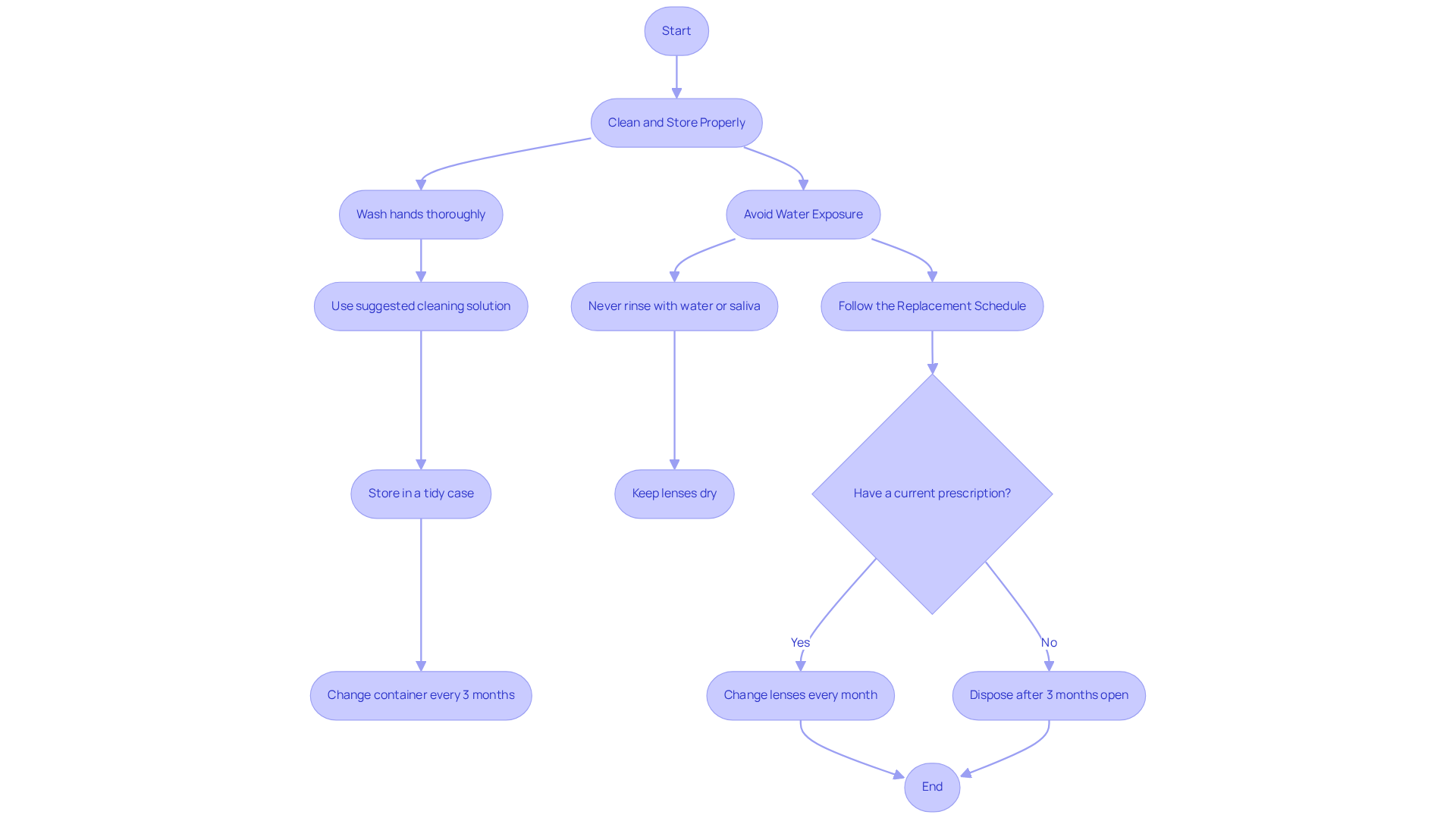
Latest Advancements in Color Contact Lens Technology
Recent advancements in tinted eyewear technology have significantly improved the user experience, especially with the introduction of innovative materials and designs.
-
Improved Materials: We understand how important comfort is, especially during extended use. The latest optical materials enhance oxygen permeability, crucial for maintaining eye health. These advancements help alleviate dryness and irritation, making tinted lenses more pleasant for everyday wear. Industry reports indicate that the colored contact products market is anticipated to expand at a CAGR of 10.60% during the forecast period, reflecting the rising demand for such innovations.
-
Customization Options: It’s common to want eyewear that reflects your personal style. Innovations in manufacturing processes now allow for personalized color matching and effects, enabling you to achieve your desired aesthetic with greater precision. This degree of personalization caters to individual tastes, making colored optics more attractive for both aesthetic and corrective purposes. As highlighted by industry experts, “The increasing impact of social media and the wish for improved facial aesthetics are fueling the need for customized colored eyewear.”
-
Intelligent Optics: We know how exciting it is to see new technology in action. New developments are creating opportunities for smart optics that can adjust their hue according to surrounding illumination. This groundbreaking idea introduces a dynamic aspect to colored lenses while also creating opportunities for improved functionality, such as incorporating health-monitoring features.
These innovations not only enhance comfort and safety but also reflect a growing trend towards personalization in the color contacts prescription market. Many patients have reported improved satisfaction with new materials that offer better comfort and visual clarity. As the industry evolves, the focus on user experience and technological advancements will likely continue to drive demand and shape future developments. We are here to help you through this process.
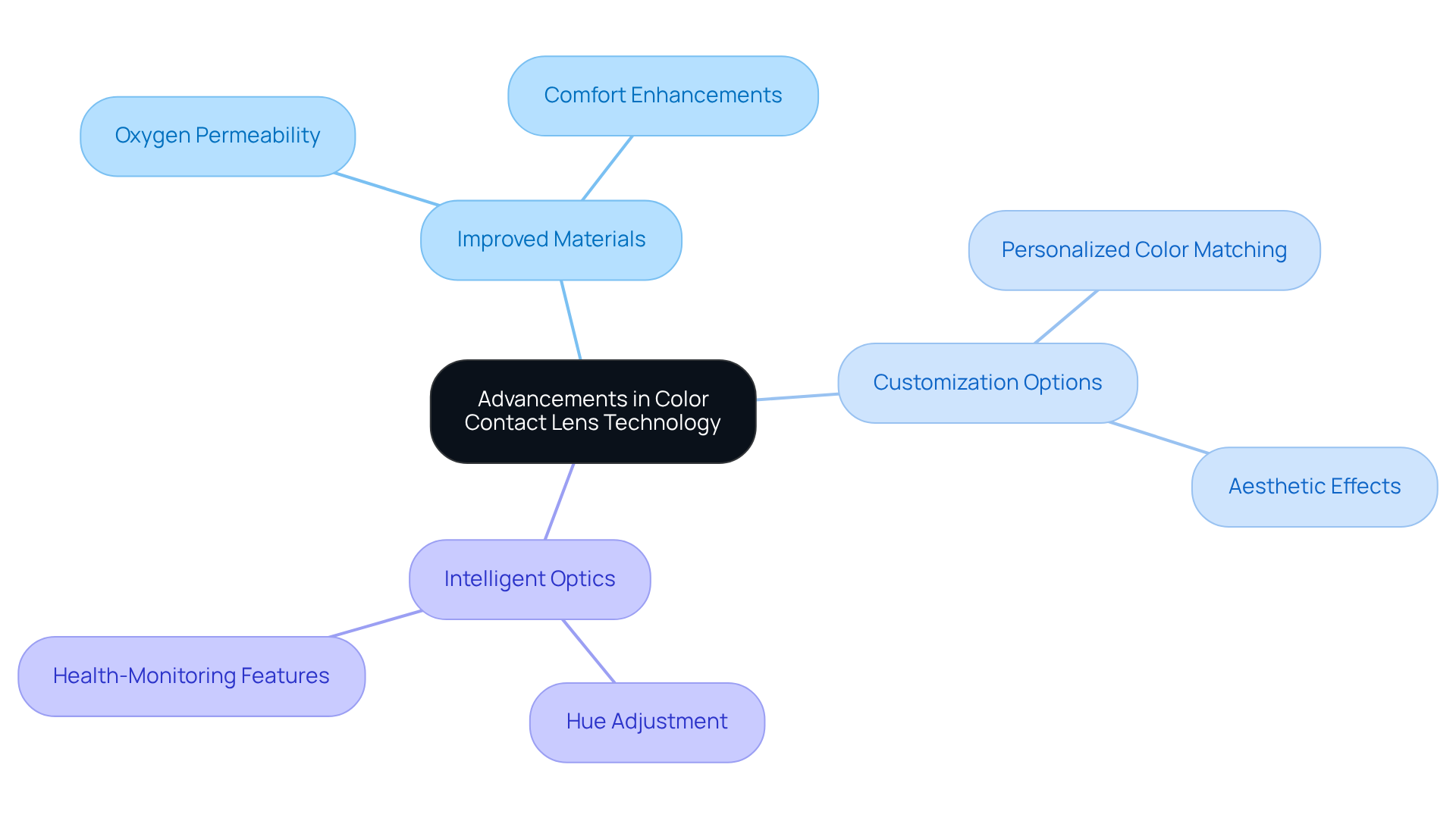
Conclusion
Ensuring safety and comfort with color contact lenses is paramount for anyone looking to enhance their appearance while maintaining eye health. We understand that making choices about your vision can feel overwhelming. That’s why a personalized approach to color contacts prescriptions, conducted by qualified eye care professionals, is so important. This not only guarantees a proper fit but also minimizes the risk of complications. As the market for colored eye accessories continues to grow, it is essential to make informed choices with professional guidance.
Throughout this article, we shared key insights regarding the importance of professional fittings, the various types of color contact lenses available, and the necessity of regular eye exams. It’s common to feel concerned about the risks associated with improper use—such as infections and corneal abrasions. This highlights the critical nature of proper education and adherence to care instructions. Thankfully, advancements in technology have improved the comfort and safety of these lenses, making it easier than ever to find options that suit your individual needs.
Ultimately, prioritizing eye health while enjoying the aesthetic benefits of color contact lenses is crucial. Engaging with eye care professionals for personalized fittings, following best practices for lens care, and staying informed about the latest advancements will ensure a safe and satisfying experience. We are here to help you embrace the beauty of color contacts while safeguarding your vision—because informed choices lead to healthier eyes and enhanced confidence.
Frequently Asked Questions
Why is a personalized color contact lens prescription important?
A personalized color contact lens prescription is important because it ensures a proper fit tailored to an individual’s unique eye shape and vision needs, which minimizes discomfort and potential eye health complications.
What is the projected growth of the colored eye accessories market?
The colored eye accessories market is projected to grow to $6.3 billion by 2029 at a compound annual growth rate (CAGR) of 10.6%.
What are the risks of using non-prescribed color contact lenses?
Non-prescribed color contact lenses carry specific risks, including infections and corneal abrasions, with 60% of fake cosmetic eye lenses found to have microbial contamination.
What types of evaluations do eye care professionals conduct for color contacts?
Eye care professionals evaluate eye health by considering symptoms such as blurred vision, dry eyes, and macular degeneration, and they suggest suitable types of optics while providing advice on safe usage practices.
What are the main types of color contact lenses available?
The main types of color contact lenses include: – Visibility Tint: Lightly tinted lenses for easier handling. – Enhancement Tint: Semi-transparent lenses that intensify the natural eye color. – Opaque Tint: Lenses that completely conceal the natural eye color. – Scleral Discs: Larger devices covering the entire sclera for special effects.
What are the consumer preferences regarding enhancement and opaque tints?
Approximately 65% of consumers prefer enhancement tints for their ability to intensify natural eye hues, while 25% opt for opaque tints for a striking transformation.
How can color contact lenses impact a user’s confidence?
Many users report that enhancement tints improve their appearance and boost confidence, as illustrated by a user who felt more vibrant and confident while wearing them at a social event.
What advancements are being made in color contact lens technology?
Advancements in optical technology are improving oxygen permeability and comfort attributes, enhancing the user experience with tinted corrective and cosmetic options.






